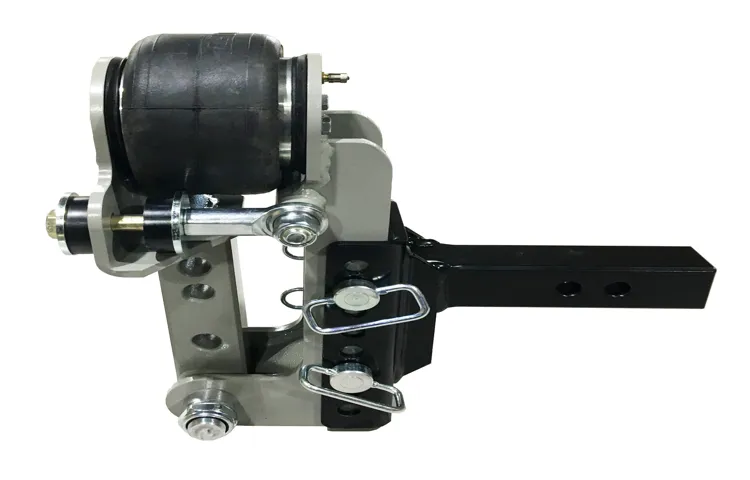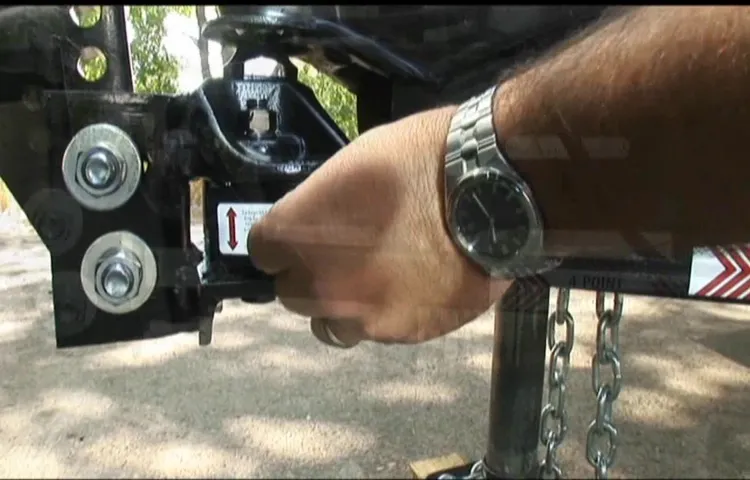Installing an equalizer weight distribution hitch can make a significant difference in your towing experience. Whether you’re towing a trailer for camping trips or hauling heavy loads, a weight distribution hitch can help distribute the weight evenly across all axles and improve stability on the road. But how exactly do you install an equalizer weight distribution hitch? Don’t worry – it’s not as complicated as it may seem.
In this blog post, we’ll take you through the step-by-step process of installing a weight distribution hitch, so you can hit the road with peace of mind. Think of a weight distribution hitch as the “balancing act” for your towing setup. Just like a tightrope walker needs a pole to maintain balance, your tow vehicle and trailer combination requires a weight distribution hitch to distribute the weight evenly between the vehicle and the trailer.
By doing so, it prevents excessive sagging of the rear axle and ensures a level ride. Before you begin the installation process, it’s essential to gather all the necessary tools and equipment. You will need a wrench, socket set, torque wrench, tape measure, and, most importantly, the weight distribution hitch kit itself.
This typically includes the hitch head, spring bars, brackets, and necessary hardware. Next, you’ll need to measure your trailer tongue height to determine the correct hitch ball height. Measure from the ground to the bottom of the trailer’s coupler when level.
This measurement will help you ensure that the hitch ball is at the appropriate height when the weight distribution hitch is installed. Once you have the measurements and tools ready, it’s time to install the weight distribution hitch. Start by attaching the hitch head onto the receiver hitch of your vehicle, making sure to tighten all bolts securely.
The hitch head should be level both horizontally and vertically. Next, attach the spring bars to the hitch head using the provided hardware. Ensure that the spring bars are correctly aligned with the brackets on the trailer frame.
Table of Contents
What is a Weight Distribution Hitch?
If you’re towing a trailer, especially a heavy one, it’s important to have a weight distribution hitch in order to ensure stability and control on the road. One popular option is the Equal-i-zer weight distribution hitch. But how do you install it? Well, the process is actually quite simple.
First, you need to measure the height of your trailer’s coupler when it is sitting level. This will determine the appropriate size of shank you need for your hitch. Next, attach the shank to your trailer hitch receiver and tighten it securely.
Then, position the head assembly of the weight distribution hitch onto the shank and secure it with the provided bolts and washers. After that, you will need to mount the spring bars onto the head assembly and attach them to the trailer frame with the included brackets and u-bolts. Finally, make sure everything is tightened and secure, and adjust the tension on the spring bars so that the trailer and tow vehicle are level.
And that’s it! With a few simple steps, you can have your Equal-i-zer weight distribution hitch installed and ready to hit the road with confidence.
Definition
weight distribution hitch

Functions
weight distribution hitch, distributing weight, towing stability, tongue weight, weight distribution bars, sway control, safety, towing capacity, trailer tongue weight, towing experience, installation process
Choosing the Right Equalizer Weight Distribution Hitch
Installing an equalizer weight distribution hitch might seem like a complicated task, but with the right guidance, it can be a straightforward process. First and foremost, it’s crucial to choose the right equalizer weight distribution hitch that suits your towing needs. This type of hitch helps to distribute the weight of your trailer evenly across all axles, improving stability and control while towing.
When selecting the hitch, consider the towing capacity of your vehicle, the weight of your trailer, and the hitch’s weight rating. Once you have the right hitch, the installation process can be broken down into a few simple steps. Start by attaching the hitch ball to the hitch head and securing it tightly.
Then, position the hitch head onto the trailer hitch receiver, making sure it is aligned properly. Secure the head using the provided bolts and tighten them according to the manufacturer’s instructions. Next, connect the spring bars to the hitch head using the provided pins and clips.
Finally, attach the other end of the spring bars to the trailer frame using the chains or brackets provided. Make sure to adjust the tension on the spring bars to ensure the proper weight distribution. It’s also essential to check the clearances between the trailer and the vehicle and make any necessary adjustments.
Installing an equalizer weight distribution hitch may take some time and effort, but the added stability and control it provides while towing are well worth it.
Determining Towing Capacity
equilizer weight distribution hitch, towing capacity
Considering Trailer Tongue Weight
equalizer weight distribution hitch
Tools and Equipment Needed
If you’re looking to install an equalizer weight distribution hitch for your trailer, there are a few tools and equipment you’ll need to get the job done. First and foremost, you’ll need the hitch itself, along with the necessary mounting hardware. You’ll also need a torque wrench to ensure that the hitch is securely tightened to the appropriate specifications.
Additionally, depending on the specific installation requirements of your trailer and vehicle, you may need a drill and drill bits, as well as a socket set. It’s also a good idea to have a level handy to ensure that your hitch is installed correctly and your trailer will be properly balanced. Lastly, don’t forget about safety equipment such as gloves and safety glasses to protect yourself during the installation process.
By having these tools and equipment on hand, you’ll be well-prepared to install your equalizer weight distribution hitch and enjoy a safe and smooth towing experience.
List of Tools
In order to successfully complete many DIY projects, you’ll need to have the right tools and equipment. Whether you’re a seasoned DIY enthusiast or just starting out, having the right tools can make all the difference. Some basic tools that everyone should have include a hammer, screwdrivers (both flathead and Phillips), pliers, and a tape measure.
These tools will come in handy for a wide range of tasks, from hanging pictures to assembling furniture. For more specialized projects, you may need additional tools such as a power drill, a level, or a saw. Having a well-stocked toolbox will save you time and frustration when it comes to tackling home improvement projects.
So, make sure you have the right tools on hand for your next DIY adventure!
Preparing the Hitch
preparing a hitch, tools and equipment needed for hitch, preparing a trailer hitch, equipment for towing a trailer, tools for installing a trailer hitch, essential tools for trailer hitch installation, necessary equipment for trailer hitch installation In order to properly prepare for hitching a trailer, there are a few essential tools and equipment that you will need. First and foremost, you will need a trailer hitch receiver that is compatible with your vehicle. This is the main component that will allow you to attach the trailer to your vehicle and is an absolute must-have.
Next, you will need a trailer hitch ball, which is the part that actually connects to the trailer. Make sure to choose a ball that is the right size and weight rating for the trailer you will be towing. Another important tool to have is a torque wrench, which you will use to tighten the nuts and bolts of the hitch securely.
This will ensure that the hitch is properly installed and will prevent any accidents or damage while towing. Additionally, having a socket set and a ratchet will be helpful for tightening any other necessary bolts or nuts. A wire brush and some lubricant can also come in handy for cleaning and lubricating the hitch and ball to ensure smooth movement.
Finally, having a level and measuring tape can be useful for ensuring that the hitch is installed correctly and that the trailer is level when attached. By having these tools and equipment on hand, you will be well-prepared to install and attach a trailer hitch safely and efficiently.
Installing the Equalizer Weight Distribution Hitch
Installing an equalizer weight distribution hitch may seem like a daunting task at first, but with the right tools and some patience, it can be done easily. First, it’s important to make sure you have all the necessary equipment and safety gear. This includes a wrench, a torque wrench, a socket set, and safety goggles.
Once you have everything ready, start by attaching the hitch head to the trailer’s frame. This is usually done by bolting it onto the A-frame using the provided hardware. Next, mount the spring bars to the hitch head and adjust their height to match the coupler height on the trailer.
This can be done by loosening the nuts on the spring bars and raising or lowering them accordingly. Once the height is adjusted, tighten the nuts to secure the spring bars in place. Finally, attach the weight distribution shank to the hitch head and make sure it is properly secured.
Adjust the angle of the shank and tighten the bolts to ensure a tight fit. And that’s it! You have successfully installed an equalizer weight distribution hitch. Remember to always double-check your work and consult the manufacturer’s instructions for any additional steps or specific requirements.
Happy towing!
Attaching the Hitch Head to the Trailer Coupler
Equalizer weight distribution hitch
Mounting the Hitch Assembly
Equalizer weight distribution hitch
Adjusting the Chains and Spring Bars
Installing the Equalizer Weight Distribution Hitch is an important step in ensuring safe and stable towing. One crucial aspect of this installation process is adjusting the chains and spring bars. These components play a vital role in distributing the weight of the trailer evenly across the tow vehicle and preventing any potential swaying or bouncing.
To adjust the chains, start by ensuring that the hitch ball is at the correct height and that the trailer is level. Then, attach the chains to the spring bars and adjust the tension. This can be done by using the included wrench to tighten or loosen the chains until they are at the desired tension.
It’s important to remember that the chains should have a slight downward angle when attached to the spring bars. Additionally, the spring bars themselves can also be adjusted. This can be done by positioning them in one of the designated holes on the hitch head, which will vary depending on the weight of the trailer.
By properly adjusting the chains and spring bars, you can ensure that your weight distribution hitch is operating effectively and providing you with a safe and smooth towing experience.
Connecting the Sway Control
connecting the sway control, installing the Equalizer Weight Distribution Hitch
Testing and Adjustment
So you’ve decided to install an equalizer weight distribution hitch on your trailer. Great choice! This hitch is designed to evenly distribute the weight of your trailer across all axles, resulting in better stability and control while towing. But how do you go about installing and adjusting it properly? First, start by attaching the hitch to the trailer tongue using the provided bolts and brackets.
Make sure it is securely fastened and aligned with the centerline of the trailer. Next, connect the spring bars to the hitch head and adjust them to the proper height, based on the tongue weight of your trailer. This can typically be done by using a wrench or socket to turn the jackscrews on the spring bars.
Once the spring bars are at the correct height, attach the chains from the spring bars to the trailer’s frame. The chains should be crossed over each other and hooked onto the brackets welded onto the trailer frame. This will provide the tension needed to distribute the weight of the trailer.
Now it’s time to test and adjust the hitch. Load up your trailer with your typical towing gear and take it for a test drive. Pay close attention to how the trailer feels while turning, braking, and accelerating.
If you notice any sway or instability, you may need to adjust the tension on the spring bars. To adjust the tension, use the jackscrews on the spring bars. Keep in mind that tightening the jackscrews will increase the tension and distribute more weight to the front axle of the tow vehicle, while loosening them will decrease tension and transfer weight to the rear axle.
Continue testing and adjusting until you find the perfect balance of weight distribution and stability. Remember, it may take a few tries to get it just right, but the benefits of a properly installed and adjusted equalizer weight distribution hitch are well worth the effort.
Testing the Hitch
When it comes to testing the hitch of a trailer, it’s essential to take the time to make sure everything is secure and in proper working order. This not only ensures your safety but also the safety of others on the road. One of the first things to do is a visual inspection of the hitch.
Look for any signs of wear or damage, such as cracks or rust. Check the bolts and fasteners to ensure they are tight and secure. It’s also a good idea to check the trailer’s wiring connection to make sure everything is properly connected and functioning.
Once you have visually inspected the hitch, it’s time to put it to the test. Hook the trailer up to your vehicle and give it a gentle tug. This will allow you to see if the hitch is securely attached and if there is any play or movement.
If you notice any movement, you may need to adjust the hitch or tighten the bolts. It’s important to remember that the hitch should not have any play or movement when properly connected. Finally, it’s a good idea to take the trailer for a short test drive to ensure everything is working as it should.
Pay attention to how the trailer handles and any noises or vibrations you may feel. If something doesn’t feel right, it’s best to address it before hitting the road. Testing and adjusting the hitch may seem like a tedious step, but it’s an essential part of ensuring your trailer is safe and ready for the road ahead.
By taking the time to properly inspect, test, and adjust the hitch, you can have peace of mind knowing that you are travelling safely.
Adjusting the Hitch Height
adjusting the hitch height When it comes to towing a trailer, it’s essential to have the hitch height properly adjusted to ensure a safe and smooth ride. The height of the hitch refers to the distance between the ground and the ball mount on the towing vehicle. This measurement is important because it affects the levelness and stability of the trailer.
If the hitch height is too low, the trailer may sag at the rear, causing handling issues and potentially damaging the trailer. On the other hand, if the hitch height is too high, the front of the trailer may lift, resulting in poor weight distribution and reduced stability. To test the hitch height, start by attaching the trailer to your towing vehicle.
Measure the height of the ball mount and compare it to the height of the trailer coupler. Ideally, the heights should match or be slightly lower on the ball mount side. If there is a significant difference, you will need to make adjustments.
Fine-tuning the Weight Distribution
weight distribution, testing and adjustment
Maintenance and Safety Tips
Installing an equalizer weight distribution hitch is a crucial step in ensuring a safe and smooth towing experience. To begin the installation process, first, gather all the necessary tools and equipment. Then, make sure to properly measure the trailer tongue height and ensure it is level.
Next, attach the hitch assembly to the trailer frame using the provided bolts and hardware, making sure to tighten them securely. Once the hitch assembly is in place, attach the spring bars to the hitch head and adjust them to the appropriate tension. Lastly, connect the trailer coupler to the hitch ball and double-check all connections and adjustments before hitting the road.
Remember, properly installing an equalizer weight distribution hitch is essential for maintaining stability and control while towing, so take the time to do it right to ensure a safe journey.
Regular Inspection and Lubrication
lubrication, regular inspection, maintenance, safety tips, maintenance schedule Prompt: Regular inspection and lubrication are crucial for the smooth operation and longevity of any machinery. Neglecting these routine maintenance tasks can lead to performance issues, breakdowns, and even safety hazards. It is important to develop a maintenance schedule that includes regular inspections and lubrication to keep your equipment running smoothly and to ensure the safety of both operators and bystanders.
By regularly inspecting your machinery, you can identify any wear and tear, loose or damaged parts, or potential problems before they become major issues. This proactive approach allows you to address any maintenance or repair needs promptly and avoid costly downtime. Additionally, lubrication is essential to reduce friction and wear on moving parts, minimizing the risk of overheating or seizing.
Proper lubrication also helps to extend the life of your equipment and improve its overall performance. So, don’t overlook the importance of regular inspection and lubrication – they are key to maintaining the safety and efficiency of your machinery.
Proper Loading and Weight Distribution
loading and weight distribution, maintenance and safety tips
Driving Safety Tips
driving safety tips
Conclusion
And there you have it, folks! Installing an equalizer weight distribution hitch is like giving your trailer a personal trainer. It takes the guesswork out of towing and ensures that your ride is as smooth as a symphony. With its innovative design and advanced technology, this hitch acts like an audio equalizer for your towing experience, leveling out any imbalances and harmonizing the weight distribution.
Just like a skilled DJ fine-tunes the sound to perfection, you can fine-tune your towing game with this hitch. Gone are the days of unbalanced loads, swaying trailers, and a bumpy ride. This hitch will have you towing like a pro, with perfect balance and stability that will make your friends green with envy.
So, if you want your towing experience to hit all the right notes, don’t forget to install an equalizer weight distribution hitch. Your trailer will thank you, your passengers will thank you, and you can proudly say that you’re the Mozart of towing.”
FAQs
What is a weight distribution hitch and why do I need one?
A weight distribution hitch is a device that evenly distributes the weight of a trailer across the axles of the tow vehicle and trailer. It helps to improve stability, control, and braking performance when towing heavy loads.
How does a weight distribution hitch work?
A weight distribution hitch works by using spring bars that connect the trailer tongue to the hitch receiver on the tow vehicle. These bars apply tension to redistribute the weight from the rear axle of the tow vehicle to the front axle and the trailer axles, creating a more balanced towing setup.
Do I need a weight distribution hitch for my trailer?
The need for a weight distribution hitch depends on the weight of your trailer and the towing capacity of your vehicle. If your trailer weighs more than 50% of your tow vehicle’s weight or exceeds the manufacturer’s recommended towing capacity, a weight distribution hitch is generally recommended for safe and stable towing.
How do I choose the right weight distribution hitch for my trailer?
To choose the right weight distribution hitch, you need to consider factors such as the trailer weight, tongue weight, tow vehicle’s towing capacity, and hitch receiver rating. It is important to consult the manufacturer’s instructions and guidelines to select the appropriate weight distribution hitch for your specific setup.
Can I install a weight distribution hitch myself?
While it is possible to install a weight distribution hitch yourself, it is recommended to have it professionally installed or seek guidance from an experienced individual. Proper installation and setup are crucial for the hitch to function effectively and safely.
Are there different types of weight distribution hitches available?
Yes, there are different types of weight distribution hitches available, such as round bar hitches, trunnion bar hitches, and Andersen hitches. Each type has its own advantages and considerations, so it is important to research and choose the one that best suits your towing needs.
Are weight distribution hitches universal or are they specific to certain trailer hitches?
Weight distribution hitches are not universal and they are designed to be compatible with specific trailer hitches. It is important to ensure that the weight distribution hitch you choose is compatible with your trailer hitch receiver for proper installation and functionality.



